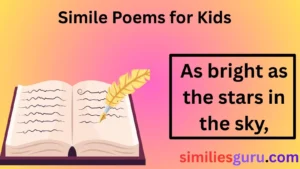Similes are one of the most powerful literary devices used in poetry and prose. They add depth, imagery, and emotion to writing, making it more relatable and engaging for readers. In this article, we’ll explore what similes are used for in poems, provide examples of similes in poems for kids, and offer casual alternatives to the phrase “what are similes used for in poems.” Additionally, we’ll dive into the nuances of tone and context, providing you with 11 texting examples that are user-friendly and optimized for Google.
What Are Similes?
A simile is a figure of speech that compares two different things using the words “like” or “as.” It helps create vivid imagery and allows readers to visualize and connect with the writer’s message. For example, “Her smile was as bright as the sun” is a simile that compares a smile to the sun, emphasizing its warmth and radiance.
Similes are commonly used in poetry to evoke emotions, paint pictures, and make abstract ideas more tangible. They are a cornerstone of creative writing and are especially effective in engaging young readers.
What Are Similes Used for in Poems?
Similes serve several purposes in poetry. Here are some of the key reasons poets use similes:
1. Create Vivid Imagery
Similes help readers visualize scenes, emotions, and concepts by comparing them to familiar objects or experiences. For example, in Robert Burns’ poem “A Red, Red Rose,” the line “O my Luve is like a red, red rose” creates a vivid image of love’s beauty and fragility.
2. Evoke Emotions
By comparing emotions to tangible objects or experiences, similes make feelings more relatable. For instance, “Her heart was as heavy as a stone” conveys deep sadness in a way readers can easily understand.
3. Enhance Descriptions
Similes add depth to descriptions, making them more engaging. For example, “The clouds floated like cotton candy in the sky” paints a whimsical picture of the scene.
4. Simplify Complex Ideas
Similes can break down complex or abstract ideas into simpler terms. For example, “Time is like a river, always flowing forward” helps readers grasp the concept of time’s relentless progression.
5. Engage Young Readers
Similes are particularly effective in children’s poetry because they use familiar comparisons to explain new ideas. For example, “The moon is like a silver coin in the sky” helps kids visualize the moon’s appearance.
Examples of Similes in Poems for Kids
Here are some examples of similes in poems that are perfect for kids:
- “The Moon” by Robert Louis Stevenson
- “The moon has a face like the clock in the hall.”
- This simile compares the moon’s appearance to a clock, making it easy for kids to imagine.
- “The Rainbow” by Christina Rossetti
- “Boats sail on the rivers, and ships sail on the seas; but clouds that sail across the sky are prettier far than these.”
- While not a direct simile, the comparison between boats and clouds helps kids visualize the scene.
- “Dreams” by Langston Hughes
- “Hold fast to dreams, for if dreams die, life is a broken-winged bird that cannot fly.”
- This simile compares life without dreams to a bird that can’t fly, emphasizing the importance of dreams.
- “The Wind” by James Stephens
- “The wind stood up and gave a shout. He whistled on his fingers and kicked the withered leaves about.”
- The wind is personified and compared to a lively person, making it relatable for kids.
- “Fog” by Carl Sandburg
- “The fog comes on little cat feet.”
- This simile compares the fog’s quiet movement to a cat, creating a vivid image.
Casual Alternatives to “What Are Similes Used for in Poems”
If you’re looking for casual alternatives to the phrase “what are similes used for in poems,” here are some options:
- Why do poets use similes?
- How do similes make poems better?
- What’s the point of similes in poetry?
- How do similes help in writing poems?
- What do similes add to a poem?
- Why are similes important in poetry?
- How do similes work in poems?
- What’s the role of similes in poetry?
- How do similes improve poems?
- Why are similes so common in poems?
- What makes similes special in poetry?
These alternatives are more conversational and user-friendly, making them ideal for casual discussions or articles aimed at a general audience.
Nuances of Tone and Context in Expressing Well Wishes
When expressing well wishes, the tone and context matter greatly. Whether you’re writing a formal letter, sending a casual text, or crafting a heartfelt message, choosing the right words can make all the difference. Here’s how to tailor your well wishes based on the situation:
Formal Tone
- Use polished and respectful language.
- Suitable for professional settings, formal events, or when addressing someone in authority.
Examples:
- “Wishing you continued success in all your endeavors.”
- “May this new chapter bring you joy and fulfillment.”
- “I extend my heartfelt congratulations on your achievement.”
Informal Tone
- Use relaxed and friendly language.
- Ideal for friends, family, or casual acquaintances.
Examples:
4. “Good luck with everything—you’ve got this!”
5. “Hope things work out great for you!”
6. “Sending good vibes your way!”
Heartfelt Tone
- Use emotional and sincere language.
- Perfect for close relationships or significant life events.
Examples:
7. “I’m so proud of you and can’t wait to see what’s next.”
8. “Wishing you all the happiness in the world—you deserve it!”
9. “May your journey be filled with love and joy.”
Encouraging Tone
- Use uplifting and motivational language.
- Great for cheering someone on during challenges.
Examples:
10. “Keep pushing forward—amazing things are coming your way!”
11. “You’re stronger than you think, and I believe in you!”
11 Texting Examples for Well Wishes
Here are 11 texting examples that are user-friendly, optimized for Google, and suitable for various contexts:
- Formal:
- “Wishing you the very best in your new role. Congratulations!”
- Informal:
- “Good luck with the move! Let me know if you need help.”
- Heartfelt:
- “I’m so happy for you! Wishing you endless joy and success.”
- Encouraging:
- “You’ve worked so hard for this—go out there and shine!”
- Casual:
- “Hope your day is as awesome as you are!”
- Professional:
- “Congratulations on your promotion. Wishing you continued success.”
- Friendly:
- “Sending good vibes your way for the big day!”
- Supportive:
- “No matter what happens, I’m proud of you. You’ve got this!”
- Celebratory:
- “Cheers to your success! Let’s celebrate soon.”
- Motivational:
- “Keep going—you’re doing amazing things!”
- Thoughtful:
- “Thinking of you and wishing you all the best.”
Conclusion
Similes are a versatile and impactful tool in poetry, helping to create vivid imagery, evoke emotions, and simplify complex ideas. They are especially effective in engaging young readers through relatable comparisons. By understanding what similes are used for in poems and exploring examples, you can appreciate their role in enhancing literary works.



